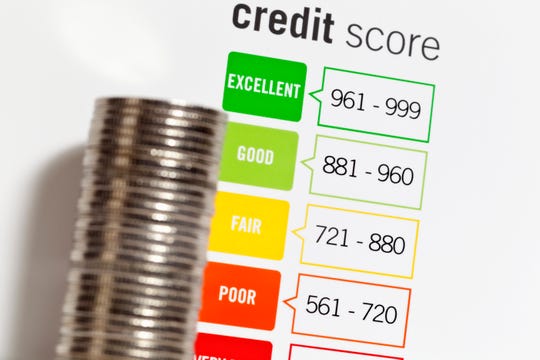

Like many Americans, Chris Gray got into financial trouble when he accumulated large medical expenses — in his case, for hip surgery four years ago.
“The medical bills just start piling up, especially if you can’t work,” said Gray, a 37-year-old Phoenix resident who works in sales and delivery for a flooring company. “You burn through your emergency savings.”
Gray’s credit score dropped into the subprime category, which made it harder to get loans at attractive rates of interest. He wound up borrowing cash using payday-advance and title-loan services.
Gray now is paying down his debts, often working 60 hours a week at his regular job and a side gig, but his financial life still isn’t back to where he wants it to be. Having a subprime credit score has limited his options.
“Until I have a great credit score, (a conventional bank loan) isn’t going to happen,” he said.
Access to credit in a pinch
When most Americans think about being middle class, they usually visualize having a certain level of income and material possessions like a car or house. But another way to think about it is having the ability to borrow money, if you need to, at affordable rates of interest.
“The new middle-class divider is access to credit,” said Jonathan Walker, executive director of Elevate’s Center for the New Middle Class, a research and advocacy group. “When unexpected expenses pop up, they can become a crisis if you don’t have access to credit.”
Having access to credit doesn’t necessarily mean using it or abusing it. A small slice of Americans are sufficiently wealthy that they don’t need to borrow money. But for most of the rest, good credit is not only desirable but represents an important financial backstop.
Perils of low credit scores
People with subprime credit scores — generally below 650 to 700 on the standard FICO scale of 300 to 850 — often can’t borrow inexpensively when they need cash, whether to build up their assets (such as by purchasing a home) or to meet emergency medical, auto-repair or other big-ticket expenses.
That means they might need to resort to high-cost borrowing in a pinch, or do without.
Some 160 million Americans have subprime scores or no credit scores, according to research cited by Walker’s group. Usually, this is because they already have fallen behind on bills, missed payments or filed for bankruptcy. When new expenses arrive, they often have trouble meeting them.
“Anyone who has to pay 400% annual interest (for a payday-type loan) probably isn’t going to be able to pay it off quickly,” said Mike Sullivan, a personal-finance consultant at Take Charge America, a Phoenix-based credit-counseling company. “Once you’re dealing with payday loans, it’s difficult to get out.”
Struggling middle-class Americans, unlike the poor, often don’t know about various safety net programs like government-subsidized food or medical problems. Either that, or they don’t think they will would qualify or are too embarrassed to request help, often viewing their difficulties as temporary, Walker said.
About 30 percent of adults are within three paychecks of needing to borrow money or missing payments on bills, according to a new Northwestern Mutual study.
What pushes debtors over the edge
A lot of factors can get people into trouble, but two factors stand out. One is a reduction of work hours, which was cited by 55% of nonprime respondents in a May survey conducted by Walker’s group. Another 24% cited medical bills as the primary cause.
Secondary factors included a big car repair (11%), leaving home for the first time (6%), and paying for a child’s college expenses (5%).
But rather than any one thing, it’s often a combination of pressures that pushes people into financial hot water and damages their credit. Of those survey respondents who cited medical costs as the primary catalyst, three in four also said they had suffered an income drop, which made it harder to handle those medical bills.
People with subprime credit scores said unexpected costs amounting to more than about 30% of their monthly income would be enough to disrupt their finances significantly. On average, it would take an average of just $1,400 or so in new obligations to push a lot of these cash-strapped individuals over the edge.
Side jobs might not help
So why not just grab an extra side job to help make ends meet? Some people do pursue gig jobs — and new cell-phone apps make it easier to find short-term work quickly.
“But it’s not so easy if you’re a single parent and have to pay child care and might not have a great car to get around,” said Sullivan. “The gig economy isn’t so welcoming for a lot of people living on the edge.”
Besides, the time lapse between losing a job and finding a new one, even if only a few weeks, can be enough to cause damage, with so many people living paycheck to paycheck.
“The low unemployment rate doesn’t mean there’s high job security,” said Walker. “Sure, you can go out and find another job, but if you don’t have savings, the gap period becomes catastrophic.”
Friends and relatives, beware
Cash-strapped individuals who are unable or unwilling to borrow at high interest rates sometimes instead reach out to family members or friends for help. That can be perilous too, if the person fails to pay back the money.
Besides risking their own cash, family members or friends who lend money or co-sign on a loan can see their own credit scores damaged if payments aren’t made on time.
“It can make someone’s financial fragility contagious to others,” Walker said.
If you find yourself hitting up friends or relatives for cash, it could be a sign that you have dropped out of the middle class.